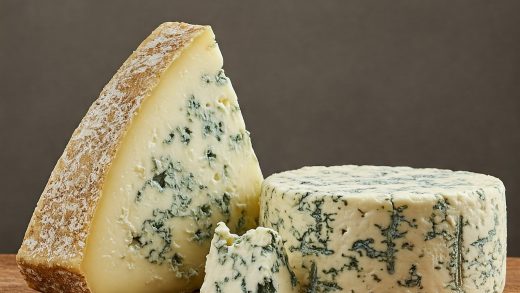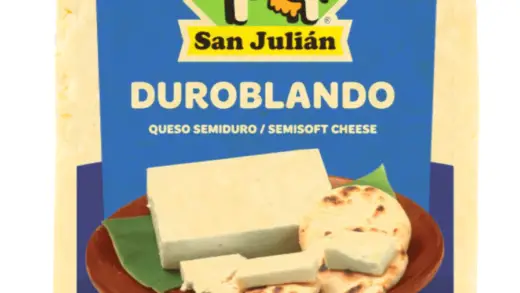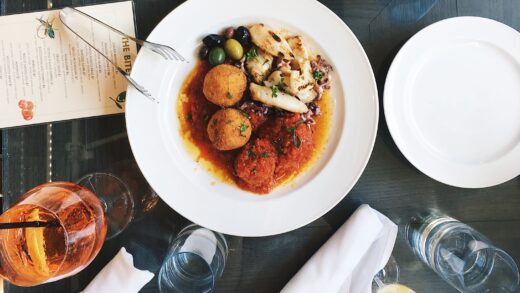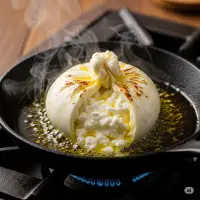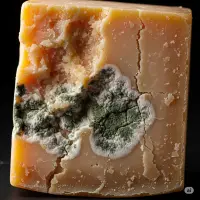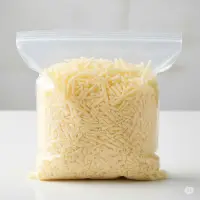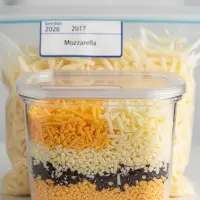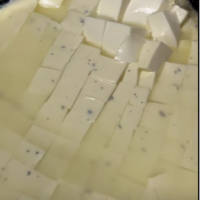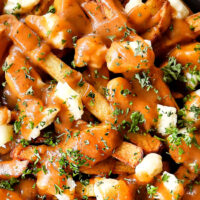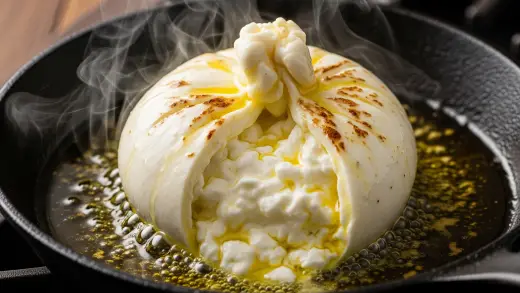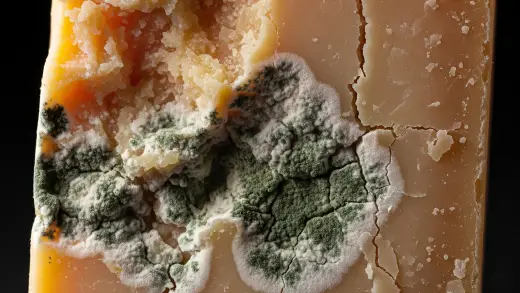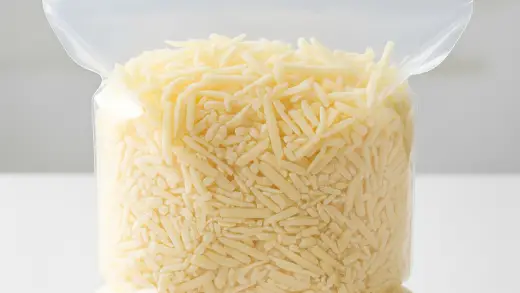Yes, you can and absolutely should eat the outside of burrata cheese.
The outer layer of burrata is a thin shell made of mozzarella cheese. It’s firm but soft and provides a delightful contrast in texture to the creamy, rich interior filling of stracciatella (shredded mozzarella soaked in cream).
Have you ever paused, gazing at a glistening ball of burrata, and wondered if you’re truly experiencing it the way it’s meant to be?
Perhaps you’ve even cautiously scooped out the creamy center, leaving behind the delicate outer layer.
Let’s clear up any confusion: Yes, the entire burrata, including its soft, mozzarella “skin,” is absolutely meant to be eaten!
This delightful Italian cheese offers a unique experience thanks to the beautiful contrast between its firm yet yielding exterior and the rich, flowing cream within.
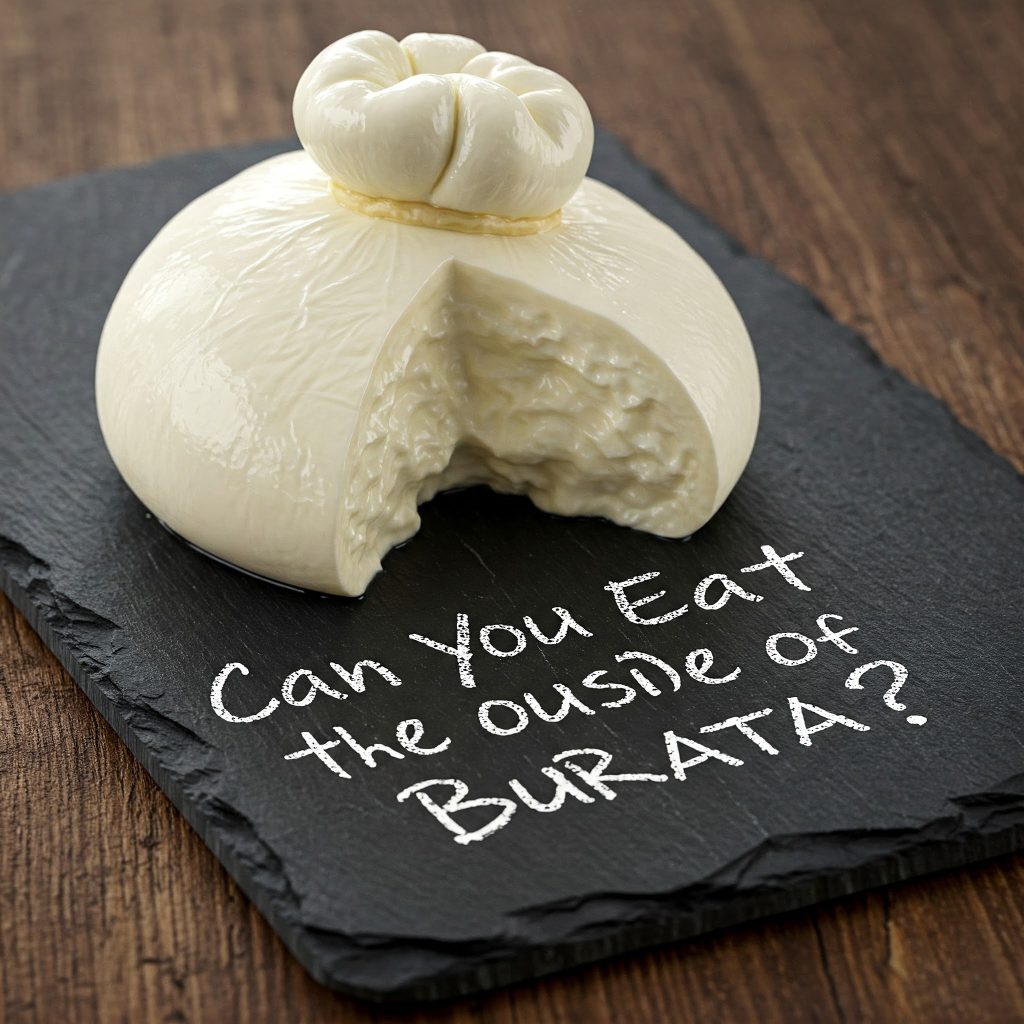
Can You Eat the Outside Of Burrata?
Yes, you can and absolutely should eat the outside of burrata cheese.
The outer layer of a burrata ball is simply a thin shell of mozzarella cheese. The delicious contrast in textures is a key part of the burrata experience – the firm, slightly chewy mozzarella shell gives way to the soft, creamy stracciatella filling inside.
Think of it like a delicious cheese dumpling where the wrapper is also cheese! Eating the whole thing together is the intended way to enjoy burrata.
Can You Eat the Outside of Burrata? Debunking Myths
Yes, The Outer Layer is Delicious Mozzarella
Contrary to any misconceptions, the outer layer of burrata cheese is not a rind or a casing meant to be discarded.
It is, in fact, a thin layer of fresh mozzarella cheese, the very same cheese that forms the “pouch” holding the creamy center.
This outer layer is perfectly edible and contributes significantly to the overall flavor and texture profile of burrata.
Why Eating the Whole Burrata is Recommended?
Eating the entire burrata, including the outer mozzarella shell, is the intended and most enjoyable way to experience this Italian delicacy. Discarding the outer layer means missing out on a crucial component of the cheese and its intended flavor combination.
Experiencing the Texture Contrast: Firm Outside, Creamy Inside
The beauty of burrata lies in its delightful textural contrast. The slightly firm and resilient mozzarella shell provides a gentle resistance before yielding to the rich, soft, and flowing stracciatella filling within.
This interplay of textures is a key characteristic of high-quality burrata and is best appreciated when the entire cheese is consumed together.
Creative Ways to Use Burrata in Dishes
You know how burrata is just so incredibly delicious on its own? Well, get ready to discover even more ways to enjoy this creamy dream.
Its unique texture and milky flavor make it a fantastic addition to all sorts of dishes, adding a touch of luxury and a burst of freshness. Let’s explore some exciting culinary adventures you can embark on with burrata:
Burrata in Salads: A Creamy Addition
Imagine biting into a vibrant salad with juicy tomatoes and fresh basil, and then encountering a pocket of cool, creamy burrata.
It’s a game-changer. Instead of just a dressing, the burrata becomes an integral part of the salad, its richness coating the other ingredients beautifully.
- Caprese Upgrade: Take your classic Caprese salad to the next level by placing a whole or halved burrata in the center. As you serve, the creamy interior will mingle with the tomatoes and basil, creating an irresistible sauce.
- Arugula and Prosciutto: The peppery bite of arugula and the salty savoriness of prosciutto are perfectly balanced by the cool, milky notes of burrata. A drizzle of balsamic glaze ties it all together.
- Roasted Vegetable Salad: Warm, roasted vegetables like bell peppers, zucchini, and eggplant pair wonderfully with the cool, fresh burrata. The contrast in temperature and texture is simply divine.
Burrata on Bread: Simple and Satisfying
Sometimes, the simplest things are the most satisfying. Burrata on good quality bread is a testament to that.
- Toasted Baguette with Olive Oil: Simply spread the creamy insides of a burrata onto toasted baguette slices, drizzle with extra virgin olive oil, and sprinkle with a pinch of sea salt and freshly cracked black pepper. Pure bliss!
- Bruschetta Topping: Instead of just tomatoes, try topping your bruschetta with a layer of burrata and then adding other delicious elements like roasted red peppers, grilled artichoke hearts, or a drizzle of pesto.
- Sandwich Upgrade: Elevate your sandwiches by adding slices of burrata. It adds a creamy, luxurious element that takes even a simple ham and cheese to a whole new level.
Burrata with Pasta: Adding Richness
Want to make your pasta dish extra special? Adding burrata is a fantastic way to do it! The heat of the pasta gently warms the cheese, making the creamy interior even more luscious.
- Simple Tomato Sauce: Toss your favorite pasta with a simple tomato sauce and then top it with a generous dollop of burrata just before serving. As you eat, the creamy cheese will melt into the sauce, enriching every bite.
- Pesto Pasta: The bright, herbaceous flavors of pesto pair beautifully with the mild creaminess of burrata. Swirl some of the creamy interior into the pesto-coated pasta for an extra layer of flavor and texture.
- Lemon and Asparagus Pasta: A light and fresh pasta dish with lemon and asparagus is wonderfully complemented by the richness of burrata. The creamy cheese adds a lovely counterpoint to the bright, slightly bitter vegetables.
Burrata on Pizza: A Post-Bake Delight
Forget adding mozzarella before baking – try placing dollops or slices of fresh burrata on your pizza after it comes out of the oven.
The heat of the crust will slightly warm the cheese without melting it completely, preserving its wonderful texture.
- Margherita Perfection: A classic Margherita pizza becomes even more decadent with the addition of fresh burrata. The creamy cheese complements the simple flavors of tomato sauce, basil, and the chewy crust.
- Prosciutto and Arugula Pizza: The salty prosciutto and peppery arugula are a match made in heaven with creamy burrata on a crispy pizza base.
- Fig and Balsamic Pizza: The sweetness of figs and the tanginess of balsamic glaze are surprisingly delicious with the milky richness of burrata.
Unexpected Pairings: Burrata in Appetizers and More
Don’t be afraid to get creative! Burrata can shine in unexpected ways:
- Grilled Peaches with Burrata and Honey: The warm, sweet grilled peaches paired with the cool, creamy burrata and a drizzle of honey create a surprisingly delightful appetizer or light dessert.
- Burrata with Roasted Grapes and Rosemary: The sweet and slightly tart roasted grapes, the aromatic rosemary, and the creamy burrata make for an elegant and flavorful starter.
- Burrata Crostini with Balsamic Onions: Sweet and savory balsamic caramelized onions are a fantastic topping for creamy burrata on toasted crostini.
So, go ahead and experiment! Burrata is a versatile and delicious cheese that can elevate a wide range of dishes. Let your culinary imagination run wild and enjoy the creamy goodness.
Storing Burrata to Maintain Freshness
You’ve got some delicious burrata, and you want to make sure it stays that way until you’re ready to enjoy its creamy goodness. Proper storage is key to maintaining its delicate flavor and delightful texture. Here’s what you need to know:
Best Practices for Refrigeration
The refrigerator is your best friend when it comes to storing burrata. Here’s how to do it right:
- Keep it in its original liquid: Burrata is typically packaged in a whey or brine solution. This liquid helps to keep the cheese moist and prevents it from drying out. Don’t discard this liquid! Store the burrata in its original container with the liquid.
- Use an airtight container: If the original packaging isn’t completely airtight or if you’ve opened it, transfer the burrata and its liquid to a clean, airtight container. This will further protect it from absorbing odors from other foods in your refrigerator.
- Store in the coldest part of the fridge: The back of the bottom shelf is generally the coldest and most consistent temperature zone in your refrigerator. This is the ideal spot for your precious burrata.
How Long Does Burrata Stay Fresh?
Burrata is a fresh cheese and is best enjoyed as soon as possible after purchase. However, when stored correctly, it can typically last for:
Check the “best by” or “use by” date: Always refer to the date printed on the packaging. This is your primary guideline for freshness.
Generally 2-3 days after purchase: If there’s no specific date, aim to consume the burrata within 2-3 days of buying it for the best quality and flavor.
Look for signs of spoilage: Even within the recommended timeframe, it’s important to check for any signs that the burrata has gone bad. These include:
- A sour or off odor.
- A slimy texture.
- Mold growth (though this is less common with fresh burrata stored in liquid).
- A significant change in color.
- If you notice any of these signs, it’s best to discard the burrata.
Tips for Optimal Flavor and Texture
To truly savor your burrata:
Don’t freeze it
Freezing burrata is generally not recommended as it will significantly alter the texture of both the outer mozzarella shell and the creamy stracciatella filling, making it grainy and less enjoyable.
Bring it to room temperature before serving
About 20-30 minutes before you plan to eat it, take the burrata out of the refrigerator. This allows the flavors to fully develop and the creamy interior to become even more luscious.
Handle gently
Burrata is delicate. Handle it with care to avoid breaking the outer shell before you’re ready to serve it.
Why You Should Eat the Entire Burrata?
Discarding the outer mozzarella layer of burrata is like missing the opening and closing notes of a beautiful melody. Here’s why enjoying the whole cheese is the way to go:
The Perfect Harmony of Flavors
The mild, fresh flavor of the mozzarella shell acts as a wonderful counterpoint to the intense richness of the stracciatella filling.
Eating them together creates a balanced and nuanced flavor profile, where neither component overpowers the other.
The subtle tang of the mozzarella complements the sweet creaminess within, leading to a more complete and satisfying taste experience.
A Symphony of Textures
As mentioned earlier, the contrast in textures is fundamental to the enjoyment of burrata. The slight resistance of the outer shell gives way to the incredibly soft and flowing interior, creating a delightful sensation in your mouth.
This interplay between firm and creamy is what makes burrata so unique and appealing.
The Traditional Way to Enjoy
In Italian cuisine, where burrata originates, it is customarily served and enjoyed in its entirety. This approach respects the craftsmanship of the cheese maker and allows for the full intended sensory experience.
No Waste, Just Deliciousness
Ultimately, by eating the whole burrata, you are ensuring that no part of this delicious cheese goes to waste. Every element contributes to the overall flavor and texture profile, and discarding the outer layer means missing out on a significant part of the culinary experience.
How to Best Enjoy Burrata (Serving Suggestions)
Burrata’s versatility makes it a fantastic addition to various dishes. Here are some ways to savor it:
Serving it Simply
A drizzle of high-quality extra virgin olive oil and a sprinkle of sea salt are often all that’s needed to highlight burrata’s inherent flavors.
Alongside crusty bread
Use the bread to scoop up the creamy interior and enjoy it with the mild outer layer.
Pairing Ideas
- With fresh, ripe tomatoes and fragrant basil for a classic Caprese variation.
- Alongside thinly sliced cured meats like prosciutto, where the saltiness contrasts beautifully with the creamy cheese.
- Broken over fresh salads to add a luxurious and creamy element.
- As a topping for pizza (add after baking to maintain its creamy texture).
- Served with roasted vegetables, where its coolness and richness provide a lovely counterpoint.
- Believe it or not, its creamy texture can even lend itself to some unique dessert applications when paired with sweet elements like honey or figs.
Serving Temperature
Burrata’s flavors and textures are best appreciated when served at room temperature, allowing the creamy interior to become even more luscious.
Common Misconceptions About Burrata
One common misconception is that the outer layer of burrata is a “rind” that should be removed, similar to some aged cheeses.
It’s crucial to clarify that this is not the case. While some natural cheese rinds can be inedible due to their texture or the presence of specific molds, the mozzarella shell of burrata is simply fresh cheese.
It is made from the same high-quality milk and is intended to be enjoyed along with the creamy filling.
Burrata vs. Mozzarella: Understanding the Difference
While both burrata and mozzarella share a common heritage, they offer distinct culinary experiences. Here’s a breakdown of their similarities and key differences in a table format to help you understand when to best use each cheese:
| Feature | Burrata | Mozzarella |
| Base Ingredients | Fresh cow’s milk, rennet, salt, cream (for filling) | Fresh cow’s milk (can also be buffalo), rennet, salt |
| Texture | Outer shell: Thin, smooth, slightly firm. Inner filling: Soft, creamy, and flowing (stracciatella – shredded mozzarella soaked in cream). | Solid, smooth, and elastic. Can range from very soft and milky (fresh, like bocconcini) to firmer (low-moisture). |
| Filling | Contains a rich, creamy center (stracciatella). | Solid throughout; no liquid filling. |
| Flavor | Milky, fresh, with a rich, buttery, and slightly sweet creamy interior. | Mild, milky, and fresh. Flavor can vary slightly depending on the milk source. |
| Serving Style | Best served fresh and often enjoyed whole or gently cut to reveal the creamy center. Often drizzled with olive oil or balsamic glaze. | Versatile; can be eaten fresh, melted, or cooked. Often sliced, cubed, or shredded. |
| Common Uses | Salads (for creamy texture), simple preparations on bread, topping for pizzas (added after baking), pasta dishes (added at the end for richness), appetizers where the creamy center is a highlight. | Caprese salads, pizza topping (before baking), pasta dishes (melts well), sandwiches, skewers, fried mozzarella sticks. |
| Shelf Life | Shorter due to the fresh cream filling; best consumed within a few days of purchase. | Varies depending on type and packaging; fresh mozzarella has a shorter shelf life than low-moisture varieties. |
Conclusion
To reiterate, the entire ball of burrata, from its delicate mozzarella shell to its oozing stracciatella center, is not only edible but also essential for the complete and most satisfying culinary experience.
By embracing both the firm exterior and the rich interior, you unlock the true harmony of flavors and textures that makes burrata so beloved.
So, the next time you encounter this exquisite cheese, don’t hesitate – slice into that pristine white orb and savor the delightful explosion of creamy goodness and the gentle resistance of its mozzarella embrace. You’re in for a treat.
